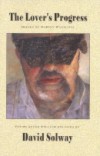
|
The Lover’s Progress
by David Solway
Porcupine’s Quill, 2001
Reviewed by Stephen Brockwell
The Lover’s Progress appears to me to be David Solway’s verse exegesis on the impossibilities of writing poems in a nihilistic, solipsistic technocracy. The Lover expresses his complaints in poems marred by purposefully awkward diction and colloquial phrasing, with brief snippets of the literary canon dropped in the poems like ice cubes in the Lover’s evening Scotch. Solway too cleverly sabotages the work in a peculiar effort to expose and condemn the catalogue of what he acutely perceives as the naïve practices of contemporary poetics. The lover is less a cultural dilettante and jet-setting persona and more David
Solway, poet, essayist, and game-playing lover of intellectual sophistication.
Consider Solway’s impression of “gangsta” language or performance poetry:
Dat smoothy at de mike
he say, Down Rhona down
bring dat Suthun Comfoht ovah heah!
and dat uddah dude wit de beahd
he say:
a love that does not discriminate
forfeits all claims upon its object.
(“At the Disco”)
Phoney closing erudition and cynicism smother this poem. It is as though the literary dabbler were mocking bad style. The oversimplification of the elided r and the toothless consonantal substitution of d for th make this poem painful to read not, however, for the clues it provides to the Lover’s ability to dabble.
In “Visiting the Caves”, a few lines have a conspicuous weakness:
They are ranged in two rows
along the side-benches of the bark,
chatting, doing crosswords
The poem closes with the perplexing line,
All symbolic as hell.
I am convinced that the passive voice of the first line, the puzzling use of the auxiliary verb “do” and the colloquial vagueness of the final line (recalling, perhaps, “mad as hell”) are all deliberate examples in verse of the trial of contemporary poetics that Solway discusses with formidable insight in his essay “The End of Poetry”:
If the imitation of nature is the privilege or the proper sphere of the novel, and the imitation of disciplinary or parietal form has been consigned to oblivion, it seems reasonable that poetry is confronted with only two options, namely, it must be either prosaic or irrelevant. There is no tertium quid. It reflects and participates in the modern experience of universal chaos and predictably disintegrates, becoming discontinuous, haphazard, and
aleatory, or variously smuggles an extraneous concept of order into its performative ambience and so reduces itself to a parasitical and undistinguished existence, encroaching on the terrain of the novel only to be wiped out or incorporated. This is where the imitation of nature inexorably leads it. The other alternative is equally depressing: it opposes the experience of violence and anarchy and stays equally clear of the giantocracy of the novel, setting up a small, countervailing linguistic system predicated on order and continuity. Thus it becomes instantly obsolete and intensely private, the formal expression of nostalgia for a lost coherence.
(“The End of Poetry”, Random Walks, McGill-Queen’s University Press, Montreal)
“City of Lost Connections,” for example, ironically recalls the style of his beautifully crafted “Morning” from
Saracen Island:
At the Sunset Bar
you can get a BJ
for a whiskey soda.
In Hampstead
marriage is
the visible embodiment of
bad karma:
on the night table stand
the Kama Sutra and Kahlil Gibran.
On Crescent Street
the circular bed
and the mirror on the ceiling
reprieve the myth:
Narcissus resuscitated.
While beneath the Morning Star
on St. Lawrence Boulevard
rides the transvestite
in the back seat of the patrol car.
(“City of Lost Connections”)
The black olive
XXXXshakes the cup of the morning glory
XXXXlike a fisherman swirling his cognac glass
XXXXto catch the early sun
and the small bee
XXXXsports little Turkish pants of pollen
XXXXsnitched from his campaign
XXXXamong the geraniums.
The spider
XXXXspinning in the baby's bassinet
XXXXmeans no harm
XXXXand will not hurt him.
(“Morning”, Saracen Island, The Poems of Andreas Karavis, Véhicule Press, Montreal, 2000)
Rhetorically, these are remarkably similar poems in their indicative movement of the eye along a path of focal subjects. I was struck by the contrast of the closed language of “City of Lost Connections” and the unselfconscious ambiguity of “Morning.” From a poet so careful in his choice of words, it is easy to believe, for example, that the anachronistic “St. Lawrence Boulevard” is deliberately nostalgic, positioning the gadabout character of these poems as an Anglophone exemplar of the linguistic tyranny that would also persist in calling Boulevard Réné Levesque by its former name, Dorchester.
But the depth of this lover’s reference does not create a convincing persona. A character that “enjoys a reasonably independent lifestyle, speaks several different languages, and has a taste for literary dabbling” has much in common with the author of these poems. Proof of this came for me in “Reconsiderations”:
O Serenissima
where are the grand old days?
Paparazzi springing out of the bushes?
Porfirio Rubirosa
and his red Ferrari?
The sweet sound of the ocarina
and the rosewood lute?
The donna angelicata?
The cultivated nuncios?
The count your master’s known munificence?
(“Reconsiderations”)
The line from Browning’s “My Last Duchess” – a poem Solway has devoted much thought to – convinced me that the lover and the poet are too close. While this poem recalls the very best of Solway’s impeccable musicality, it is part of a game that this reader found tiresome.
In the lengthy introduction to The Lover’s Progress, Solway legitimizes his project by positioning the poems in the quasi-narrative of
The Rakes’ Progress, William Hogarth’s series of engravings. The introduction has the tone of an apology and an explication; rather than let the poems rest before the reader’s gaze like paintings in a gallery or like engravings on a table, Solway stands before the reader like a tour guide at the National Gallery, providing the undergraduate reader with prescriptive reading instructions:
With respect to my original model and in keeping with Hogarth’s progressive darkening of his theme as a principle of development, I invoked the notion of successive States to suggest not merely the increasingly penseroso nature of my character’s domestic melodrama but to chart his occasionally exotic itinerary from on place to another as he tries with a certain desperate insouciance to put his future behind him.
One of the joys of Hogarth’s The Rake’s Progress is the effortless simultaneity of authorial absence and presence: a scene is presented that at first glance appears incidental and allegorical. But as the viewer surveys the boundaries and the background, wonderfully comic gestures come into view. An example of this technique is the presentation of the courting pair of dogs in the foreground and the fighting servants in the background of Plate V of the series where the rake is about to prolong his life of excess by marrying a wealthy old woman, who, upon close observation, is winking at the Minister. In the essay “Manly Satire in A Rake’s Progress”, Mark Hallet observes,
Hogarth, we find, is maintaining the graphic artist’s traditional role as someone who self-consciously meshed a variety of materials for ironic, comic and acidic effect. In this process, meaning and interpretation are deliberately destabilized and multiplied, and a figure like Tom
Rakewell, even as he is understood in terms of a specific masculine stereotype, becomes a pictorial site overlaid with alternative narratives and connotations.
(Mark Hallet, “Manly Satire in A Rake’s Progress”, page 148 in The Other
Hogarth: Aesthetics of Difference, Princeton University Press, Princeton and Oxford, 2001, edited by Bernadette Fort and Angela Rosenthal.)
Solway certainly makes use of this strategy in The Lover’s Progress and the effect, at its most convincing, puckers the mouth with its acidity. But the sense of the character as a site is obscured in
The Lover’s Progress; the voice is unsteady, and the short distance between the Lover and the poet blurs the poems. I suppose these ambiguities of voice are the rules of this elaborate game.

One key to the success of Solway’s Saracen Island, a favourite book of mine, is the near-complete submission of the author to the project and Karavis’ resilient effort to maintain Solway in his role as translator. The discipline of distance, so strong in
Saracen Island, is not sustained in The Lover’s Progress. The poems in
Saracen Island breathe with their own expressive language without conspicuous cleverness. To illustrate this point, consider the following excerpt from a poem that I can recite more or less from memory – a measure Solway prescribes for a successful work:
A man might glory
in depravation, take cue or true example
from his fields, rake the sky
for leaves of cloud and be
in love with barrenness, yet
who can live on heather and dry thorns.
(“The Islander’s Complaint”, Saracen Island, the Poems of Andreas
Karavis, Véhicule Press, Montreal, 2000)
In Saracen Island, Solway has written brilliant, memorable poems from the barren rock of remote Aegean islands and the sardonic voice of
Karavis. In The Lover’s Progress Solway miscasts a character that, as a far too erudite cultural dabbler and far too sensitive failed lover, never frees himself from the self-consciousness of the author’s direction.
And yet, this was a valuable book to read for its aggressive confrontation with contemporary experience and contemporary poetics that infects the reader with
a profound sense of loss. Solway sincerely loves intellectual vigour and linguistic
rigour. He tirelessly critiques a culture that obfuscates the robust development of the intellect in the interest of employability and amusement. The unsuccessful poems in
The Lover’s Progress are remarkable to me as rare missed steps in Solway’s hopefully long-remembered confrontation with over-simplified, naïve poetic strategies. Few poets have explored the irony of writing poetry in the information age with Solway’s hope, wit and clarity.
Stephen Brokwell's
second book, Cometology, was published by
ECW in spring 2001. His poem Parthenon
Stallion's Head appeared in The Danforth Review.
|